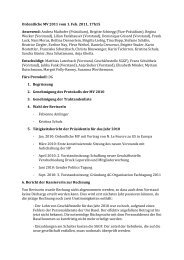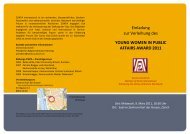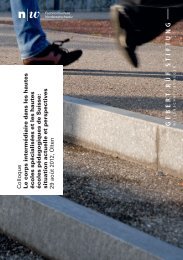Gender-Gesundheitsbericht Schweiz 2006 - Gender Campus
Gender-Gesundheitsbericht Schweiz 2006 - Gender Campus
Gender-Gesundheitsbericht Schweiz 2006 - Gender Campus
Erfolgreiche ePaper selbst erstellen
Machen Sie aus Ihren PDF Publikationen ein blätterbares Flipbook mit unserer einzigartigen Google optimierten e-Paper Software.
Moreover, there is a need to take a closer look at gender stereotypes in the field of mental<br />
health. There are indications that epidemiological research instruments display a gender<br />
bias; typical male reactions to stress are not registered, for example, and there is a<br />
similar problem concerning the diagnosis of depression. The development of gendersensitive<br />
instruments is important not least because although there is much evidence for<br />
the existence of gender differences, their causes have as yet hardly been investigated.<br />
For the reduction of infectious and non-infectious diseases, the principle of gender mainstreaming<br />
must be more strongly integrated into clinical and public health research, and<br />
into healthcare provision itself. Epidemiological data show, for example, that there are<br />
clear gender-specific morbidity and mortality rates, particularly in middle age. Cardiovascular<br />
diseases and cancer are relevant causes of death for women and men, whereas<br />
accidents are mainly significant causes of death among men. The grounds for gender<br />
differences in mortality can primarily be attributed to gender-specific health-risk behaviour<br />
and more dangerous living and working conditions for men. Women and men are<br />
affected to a different extent by many diseases, however, so far these gender differences<br />
have not been comprehensively studied. One exception is in the area of heart<br />
disease: here it emerges that women’s symptoms are misinterpreted, there is no available<br />
diagnosis suitable for both genders, and furthermore women and men benefit from<br />
specific diagnosis and therapy to different extents. These findings can be used to significantly<br />
enhance the quality of care and to increase gender equality in the health system.<br />
In order to reduce injuries due to violence and accidents, particular attention should be<br />
given to younger men up to middle age. Overall, men are roughly 2.5 times more at risk<br />
than women of dying as a result of violence and accidents. There is a need for research<br />
and intervention in connection with accidents, particularly on the issue of how men and<br />
women can be justly addressed in order to tackle the identity-forming aspects of highrisk<br />
behaviour among young men (e.g. in traffic). Both women and men are victims of<br />
violence. However, whereas men tend to experience non-domestic violence, women are<br />
more frequently exposed to violence in their closer social circle. Violence constitutes a<br />
problem that must receive more attention in the context of health-related intervention<br />
and prevention in future, and cannot be dealt with adequately without explicitly taking<br />
gender into account.<br />
To promote a gender-based approach to maintaining a healthy and safe natural environment,<br />
gender-differentiated data collection and the creation of a gender-oriented database<br />
must be implemented as central criteria in environmental studies. The relevancy of<br />
gender aspects is demonstrated, for example, in workplace-related and everyday exposure<br />
to chemicals. Specific toxicokinetic features and differing sensitivities to toxic substances<br />
can lead to gender-specific differences in exposure to chemicals in the everyday<br />
environment. Men and women are also differently affected by urban and traffic planning<br />
measures and exhibit differing transport use behaviour. Numerous research projects in<br />
the context of health and the environment directly touch on gender issues, however they<br />
do not usually analyse their findings separately by gender. Insufficient “know-how” regarding<br />
the possible integration of gender perspectives appears to be a central obstacle<br />
in the field of environmental studies in particular; as a result, no significant gendercomparative<br />
data are available in Switzerland.<br />
Summary <strong>Gender</strong> Health Report Switzerland | 22













